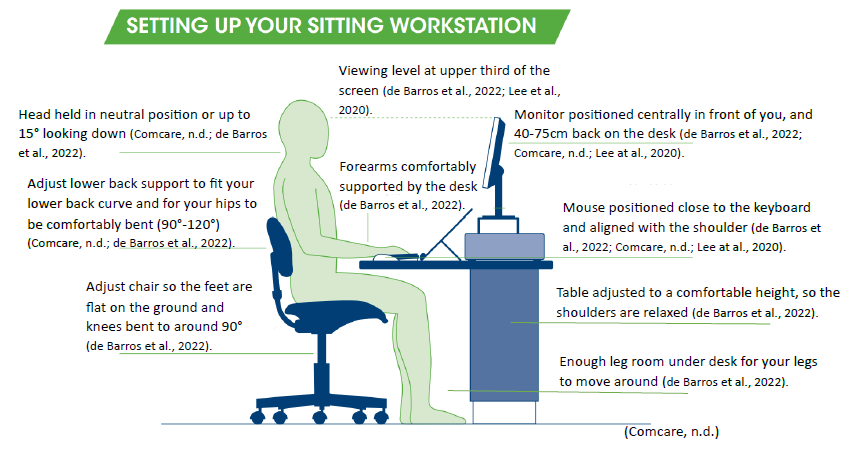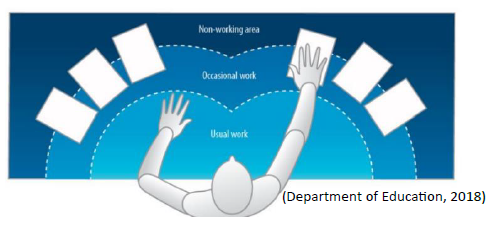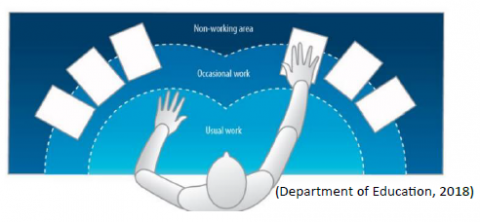Have you experienced prolonged body aches or pain while at work? Well, you are not alone!!
➔ Work-related musculoskeletal disorders (WMSD)
Work-related musculoskeletal disorders (WMSD) are the most common health related workplace conditions caused by
uncomfortable or unsafe environments (Lee et al., 2022; Russo et al., 2021).
WMSD commonly affects the muscles, joints, and other structures within the
neck, lower back, and hands/wrists (Akkarakittichoke et al., 2021; Joshi & Deshpande, 2019).
These disorders can lead to an increased number of absences from work and
reduced well-being of workers (Lee et al., 2022; Sormunen et al., 2022; Weatherson et al., 2020).
➔ Prolonged sitting
Prolonged sitting is a common occurrence in workplaces and can have negative outcomes on your body (Akkarakittichoke et al.,
2021; Ojo et al., 2018; Weatherson et al., 2020).
These can range from WMSD (Akkarakittichoke et al., 2021), to illnesses such as heart disease, diabetes, obesity, or even poor
mental health with workers (Ma et al., 2021; Ojo et al., 2018; Weatherson et al., 2020).
➔ Heavy lifting
Manual handling and heavy loads in the office can also increase your risk of developing WMSD (Russo et al., 2021).
Such examples may be:
- Lifting heavy boxes.
- Pulling open a heavy file cabinet.
So, you may be thinking, what can be done to improve these workplace environments?
➔ Why are ergonomics important?
Ergonomics are used within workplaces to ensure safety and to reduce the risk of developing unnecessary pain/conditions in
the body (Lee et al., 2022; Sormunen et al., 2022).
Educating and empowering workers on ergonomics can improve the working environment for all
and promote a safer, more productive workplace (Russo et al., 2021; Sormunen et al., 2022).
➔ Some helpful tips and tricks
SITTING DOWN LESS:
- Using prompts and reminders to get up and move e.g., desktop or phone reminders (Department of Education, 2018).
- Alternate sitting and standing every 30 minutes (Comcare, n.d.; Department of Education, 2018; Weatherson et al., 2020).
- Walking to communicate with colleagues instead of emailing (Department of Education, 2018).
- Varying your posture frequently (Akkarakittichoke et al., 2021; Department of Education, 2018).
- Even stretching and physical activity is beneficial in reducing the risk of developing WMSDs (Sormunen et al., 2022). Some ideas could be going on a walk outside during your lunch break or stretching/moving your arms and legs both at your desk, and on your break (Department of Education, 2018).
➔ What is the proper way my desk should be set up?

➔ How you should organise your desk
- Keep items that you regularly use in front of you (Comcare, n.d.).
- Try not to clutter your desk and include the use of storage/organisers (Comcare, n.d.).
- Try and switch the mouse between your left and right hand (Comcare, n.d.).

➔ Are standing desks good?
Standing desks have been shown to have benefits for workers, such as:
- Reduction in the amount you are sitting at your desk (Chau et al., 2014; Ma et al., 2021).
- Reduce pain in the upper back, lower back, and neck regions (Chau et al., 2014; Ma et al., 2021).
- Positive effects on job satisfaction by encouraging behavioural changes at work (Ma et al., 2021)
- Although standing at work can have some health benefits, it is recommended to
implement movement and low/moderate activity in your workday (Chau et al., 2014; Ma et al., 2021).
- An example may be walking around the office or on your lunch break (Ma et al., 2021).
➔ Further help
Comcare Australia is a national authority for work health and safety, and workers’ compensation (Comcare, 2021). You can
report an incident that occurred in your workplace to Comcare if there is a:
- Death of an individual (Comcare, 2021).
- Serious injury or serious illness of a person (Comcare, 2021).
- A dangerous incident (Comcare, 2021).
The link to reporting an incident is below:
https://www.comcare.gov.au/safe-healthy-work/responding-to-an-incident#notify
If you feel like you may have a work-related musculoskeletal disorder, contacting your management for further enquiries
would be adequate.
Additionally, contacting your local GP to see if you are eligible for the chronic disease management plan. This is if you have
had a complaint lasting more than six months, where you can claim up to 5 subsidised allied health service sessions per
calendar year (Services Australia, 2023).
➔ Helpful resources:
Workstation set-up guides and infographics:
https://www.safeworkaustralia.gov.au/sites/default/files/2023-07/workstation-set-up_infographic_july2023.pdf
https://www.comcare.gov.au/about/forms-pubs/docs/pubs/safety/setting-up-your-workstation-factsheet.pdf
https://education.qld.gov.au/initiativesstrategies/Documents/ergonomics-guide-staff.pdf
Community resource:
BeUpstanding is an evidence-based program that aims to improve the health and well-being of desk-based workers
(BeUpstanding, n.d.). https://www.beupstanding.com.au/
By Liam Symonds
REFERENCES
Akkarakittichoke, N., Waongenngarm, P., & Janwantanakul, P. (2021). The effects of active break and postural shift
interventions on recovery from and recurrence of neck and low back pain in office workers: A 3-arm clusterrandomized
controlled trial. Musculoskeletal Science and Practice, 56.
https://doi.org/10.1016/j.msksp.2021.102451
BeUpstanding. (n.d.). Stand up, sit less and move more at work. https://www.beupstanding.com.au/
Buoy. (2018). Severe wrist pain. [Illustration]. https://www.buoyhealth.com/learn/severe-wrist-pain
Chau, J. Y., Daley, M., Dunn, S., Srinivasan, A., Do, A., Bauman, A. E., & van der Ploeg, H. P. (2014). The effectiveness
of sit-stand workstations for changing office workers’ sitting time: Results from the Stand@Work
randomized controlled trial pilot. International Journal of Behavioral Nutrition and Physical Activity, 11(1).
https://doi.org/10.1186/s12966-014-0127-7
Comcare. (2021). Responding to an incident. https://www.comcare.gov.au/safe-healthy-work/responding-to-anincident#
notify
Comcare. (n.d.). Workstation set-up guide. https://www.comcare.gov.au/about/formspubs/
docs/pubs/safety/setting-up-your-workstation-factsheet.pdf
Comcare. (n.d.). Workstation set – up guide. [Image]. https://www.comcare.gov.au/about/formspubs/
docs/pubs/safety/setting-up-your-workstation-factsheet.pdf
de Barros, F. C., Moriguchi, C. S., & de Oliveira Sato, T. (2022). Effects of workstation adjustment to reduce postural
exposure and perceived discomfort among office workers - A cluster randomized controlled trial. Applied
Ergonomics, 102. https://doi.org/10.1016/j.apergo.2022.103738
Department of Education. (2018). Office ergonomics - staff.
https://education.qld.gov.au/initiativesstrategies/Documents/ergonomics-guide-staff.pdf
Department of Education. (2018). Office ergonomics - staff. [Image].
https://education.qld.gov.au/initiativesstrategies/Documents/ergonomics-guide-staff.pdf
Faculty of Health and Behavioural Sciences. (2022). What the health: Should I be standing while I work? [Illustration].
https://habs.uq.edu.au/article/2022/12/what-health-should-i-be-standing-while-i-work
IconScout. (n.d.). 4,153 back pain illustrations. [Illustration]. https://iconscout.com/illustrations/back-pain
Joshi, M., & Deshpande, V. (2019). A systematic review of comparative studies on ergonomic assessment
techniques. International Journal of Industrial Ergonomics, 74. https://doi.org/10.1016/j.ergon.2019.102865
Lee, S., de Barros, F. C., de Castro, C. S. M., & de Oliveira Sato, T. (2020). Effect of an ergonomic intervention
involving workstation adjustments on musculoskeletal pain in office workers—A randomized controlled
clinical trial. Industrial Health, 59(2). https://doi.org/10.2486/indhealth.2020-0188
Ma, J., Ma, D., Li, Z., & Kim, H. (2021). Effects of a workplace sit–stand desk intervention on health and
productivity. International Journal of Environmental Research and Public Health, 18(21).
https://doi.org/10.3390/ijerph182111604
Ojo, S., Bailey, D., Chater, A., & Hewson, D. (2018). The impact of active workstations on workplace productivity and
performance: A systematic review. International Journal of Environmental Research and Public Health, 15(3),
417. https://doi.org/10.3390/ijerph15030417
Russo, F., Papalia, G. F., Vadalà, G., Fontana, L., Iavicoli, S., Papalia, R., & Denaro, V. (2021). The effects of workplace
interventions on low back pain in workers: A systematic review and meta-analysis. International Journal of
Environmental Research and Public Health, 18(23), 12614. https://doi.org/10.3390/ijerph182312614
Services Australia. (2023). Chronic disease GP management plans and team care arrangements.
https://www.servicesaustralia.gov.au/chronic-disease-gp-management-plans-and-team-care-arrangements
Sormunen, E., Mäenpää-Moilanen, E., Ylisassi, H., Turunen, J., Remes, J., Karppinen, J., & Martimo, K.-P. (2022).
Participatory ergonomics intervention to prevent work disability among workers with low back pain: A
randomized clinical trial in workplace setting. Journal of Occupational Rehabilitation.
https://doi.org/10.1007/s10926-022-10036-9
Weatherson, K. A., Wunderlich, K. B., & Faulkner, G. E. (2020). Impact of a low-cost standing desk on reducing
workplace sitting (standUP UBC): A randomised controlled trial. Applied Ergonomics, 82.
https://doi.org/10.1016/j.apergo.2019.102951

